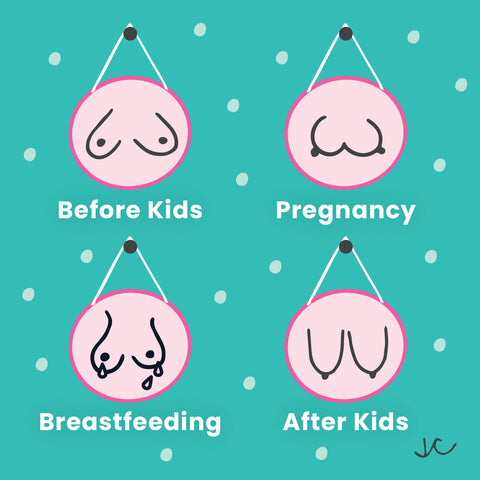7 Frustrating Breastfeeding Struggles And How To Overcome Them

Breastfeeding is amazing (and so are you by the way!)
If you’re reading this at 3 am with your Boobie monster latched on to your breast while trying to drink a cold cup of coffee... then mama... you’re our kinda woman.
It’s an incredible, empowering, wonderful journey that is packed with benefits for both you and your little bundle of joy.
But, and we know this firsthand, it can be a hell of a struggle.
From pumping woes to latching, and cluster feeding to engorgement, the list of breastfeeding struggles can seem endless. And if you’re looking for some help and support with your breastfeeding journey, then you’re in the right place.
In this article, we’re going to round up seven of the most common breastfeeding difficulties and show you how to overcome them. You’ve got this Breastie, and we are here for you on your Boobin' journey.
Breastfeeding struggles we’ve all experienced
We’re led to believe that breastfeeding is this natural and easy thing. We blame the movies! That you just whip a Titty out, hold your baby, and boom. Easy.
But the reality is that for A LOT of moms, breastfeeding doesn’t go as they expected. It can take a lot of grit, determination, tears, and so much hard work to get that squirmy little cutie to latch, and your milk to flow.
Yep. Breastfeeding doesn’t always come easily.
So, whether you are about to embark on your breastfeeding journey or you’re already on it, take note of these common breastfeeding difficulties. The more prepared you are and the less alone you realize you are, the easier it will be to get the support you need.
We’re rooting for you mama!
#1 Cluster feeding
Is your newborn cluster feeding at night? Are you finding it impossible to get more than 30 minutes shut-eye at a time?
Cluster feeding is when your little milk monster enjoys several (hundred it feels like) feeds very close together.
So, you finish a feed, stand up to make yourself a drink, and the little one starts rooting for your Titty AGAIN. It often happens in the late afternoon, evening, and at night and is SUPER common and normal in new babies. And even older babies when they don’t feel well or are going through a growth spurt.
This is an intense time, and if you are wondering how to stop cluster feeding, don’t worry. It doesn’t last for long. Babies have teeny tummies that need feeding little and often. Cluster feeding also happens during growth spurts, and in the evenings because milk production is slower at night.
But, it can be super exhausting.
What can you do?
This is one of those waves you just have to ride out mama. It’s an exhausting time, but it doesn’t last long. And those long, lazy, never-ending feeds are a great time for you to sit back, put your feet up, snuggle with your babe, and let everyone else take care of you.
Acknowledge and accept it’s going to be a breastfeeding challenge. If you are prepared and accepting of it, it’ll help you relax. Enjoy the bonding time and say yes to all the help offered. And you can always reach out for professional support if you need it.
#2 Is my baby getting enough breast milk?
This is the question all breastfeeding mamas ask themselves at some point. If you pump then you can visibly see the amount of milk your baby takes. Ditto with formula. But if you’re nursing, it can be difficult to figure out how much milk your baby is getting.
And this can cause anxiety and worry.
Which is a vicious cycle because the more you worry, the more you stress, and the more likely you are to experience breastfeeding difficulties. So, try to relax mama, because there are ways you can tell if your breastfed baby is getting enough milk.
What can you do?
There are several things you can look for to ensure your little one is getting enough of your liquid gold:
- Wet diapers Most breastfed babies have between 6-8 wet diapers a day
- Satisfied If your baby seems full and dozes off to sleep after a feed, then you can feel confident she’s a satisfied customer. If in doubt, run your finger across her cheek and see if she “roots.” If she doesn’t it’s another good sign!
- Softer Boobies If your Titties feel softer and less full after a nursing session, then it’s a good sign that your babe has had a good feed
- Swallowing Keep an eye (and ear) on your baby and watch and listen out for swallowing
- Weight gain This is the most accurate way to make sure your babe is getting enough of the good stuff
Watch for these signs for peace of mind.
#3 Mastitis
This is a nasty one, but it’s a breastfeeding struggle a lot of women face, especially in the early days of feeding.
Mastitis is a bacterial infection that happens when a blocked milk duct is not relieved. As well as making your Titties feel hot, tender, and painful, it can also make you feel downright rotten - similar to the flu.
It can start as a warm, red spot on your Boob, and quickly turn into a full-blown infection. So, if you see or feel a spot like this, take it as a warning sign that you could be developing mastitis.
What can you do?
First, you can try to prevent mastitis from happening by watching out for things like engorgement. Massage your Boobs while nursing or pumping, and try to empty the breast after each session.
If you suspect mastitis, then it’s important to continue nursing, as your baby’s efficient mouth can help draw the milk out. If it becomes very painful or you feel more unwell then it’s important to see your doctor ASAP. as you might need antibiotics.
#4 Engorgement
Ugh, this is one of those breastfeeding struggles that pretty much every single nursing mom goes through at some point - especially in the early weeks.
Engorgement is when your amazing Titties are FULL of milk and need to be emptied...like now! They might feel tight, painful, and hard. And big.
This might be because your baby has gone a bit longer between feeds, or even slept through the night. It can take your milk supply a few days to adjust to your little one’s needs, which is why this is such a common issue. And although it can be super uncomfortable, luckily there are some easy fixes.
What can you do?
There are two options to help with engorgement.
- Encourage your baby to nurse to relieve the pressure and suck out as much milky goodness as they can
- Pump! You can use a breast pump to express just enough milk to take the edge off or even hand express. Then you can choose to use the expressed milk now or freeze it for later
#5 Low breast milk supply
Firstly, it’s super rare to have a low breast milk supply. So please, try not to worry too much.
Although there are some things that can damage your supply (such as not feeding on demand and not taking care of yourself,) you most likely do have a good supply, you just need some reassurance. Look for the signs we talked about earlier to check and see if your baby is getting enough milk. If you are concerned then speak to your doctor or breastfeeding consultant.
If you do want to boost your supply, there are a few things you can do.
What can you do?
Follow these steps to ensure your supply is bountiful:
- Ask your breastfeeding specialist or midwife to watch you nursing so they can offer guidance and support on positioning and latching
- Feed your baby as often as they want and for as long as they want (feeding on demand)
- Avoid using bottles or formula or a pacifier for the first 6 months or until breastfeeding is well established
- Offer both Boobs at every feed
- Enjoy lots of gorgeous skin to skin quality time
- Drink LOADS of water...and then drink some more
- Have plenty of rest (easier said than done, we know!)
And remember, anxiety and stress can have a negative impact on your supply, so always look after yourself and make sure you get the help and support you need.
#6 Painful latching or difficulty latching
This breastfeeding struggle is high up on the list as something most mamas experience.
Latching.
A good latch is vital for your baby (and for you.) For them, it’s important for getting enough milk, and for you, it’s important for keeping breastfeeding pain-free.
They don’t really tell you this, but breastfeeding is a skill. It’s something you and your Boobie monster need to learn together. Very few babies and mamas nail it on the very first feed. It takes time, practice, and a hell of a lot of patience. If you are struggling to get your babe to latch on like a pro, there are some things to try.
What can you do?
Is there a breastfeeding latch trick you can try? Well. Maybe not a trick, but there are things you can do to ensure that latch works for both of you.
When your baby latches on with a big, open mouth, you shouldn’t feel any pain. This is because they latch onto your juicy areola – which gets the milk flowing. However, if they clamp onto your nipple. OUCH!
The right latch can make or break your breastfeeding journey.
So, here are some breastfeeding latch tricks you can try:
- Make sure you are in a comfortable position. Prop your feet up and use a nursing pillow
- Hold your baby’s body close to yours and have his nose level with your nipple
- Make sure his top lip can brush against your nipple – he might need to tip his head back slightly for this. This position should allow him to open his mouth wide
- With his mouth open, check his chin and little tongue can comfortably touch your breast
- Now his chin is touching your breast, make sure his nose is clear, let him take a big mouthful of your breast. You should see some of your areola above the top of his lip, and his cheeks should look full and round. And totally squishable
If you still don’t feel comfortable or confident with your latch, or baby won’t latch, then early intervention is key. If in any doubt speak to your breastfeeding consultant or midwife.
#7 Thrush
Have you been noticing white patches in your little one’s mouth? Has she been very fussy during feeds? And have you been experiencing any breast or nipple pain? Then you might both have thrush.
Thrush infections can happen when your nipples become cracked and damaged during breastfeeding and pumping. When this happens, the oral yeast infection that causes thrush can make its way into your breast and nipple.
And thrush spreads easily back and forth between you and baby, making it a pain to get rid of. If you’ve ever experienced vaginal yeast infections, you can imagine how uncomfortable this must be for your little one.
What can you do?
Luckily, thrush is easily treated with antifungal medication.
You can continue breastfeeding while you are being treated, and symptoms should improve within a few days. But we also recommend following these tips while having treatment:
- Wash your hands thoroughly after nappy changes
- Use separate towels to prevent the infection from spreading
- Wash and sterilize dummies, teats, and any toys baby puts in his mouth
- Wash your nursing bras and reusable breast pads at a high temperature
If you don’t notice an improvement within a week then speak to your doctor.
You're rocking it Breastie!
Mama, what you are doing is one of the hardest and most challenging parts of motherhood. Breastfeeding difficulties are so normal, whether it’s your first baby or your tenth! Just remember that you are never alone and that so many moms face breastfeeding struggles.
Most importantly, don’t keep your struggles to yourself. If you feel like you need some help and support, reach out to organizations, speak to other moms, vent to your Breasties, or lean on your partner. You’re doing everything in your power to look after your little one - just don’t forget that you need looking after too.
What have been some of your biggest breastfeeding challenges, and how did you overcome them? Share them in the comments below - you might be able to help someone else with your advice.
Be sure to check out some of our other blog posts on the Let's Talk Titties blog and shop for new mama gifts to give yourself for all of your hard work.
All the Breast,
xx Jessy and the Titty Team
At Titty City Design, we believe that every boobie is beautiful, and that should be celebrated. We are a female owned and operated, small business here to spread self love and body positivity with our line of products for the home. A portion of our proceeds go to help support postpartum women and breast cancer patients.
Featured Products







